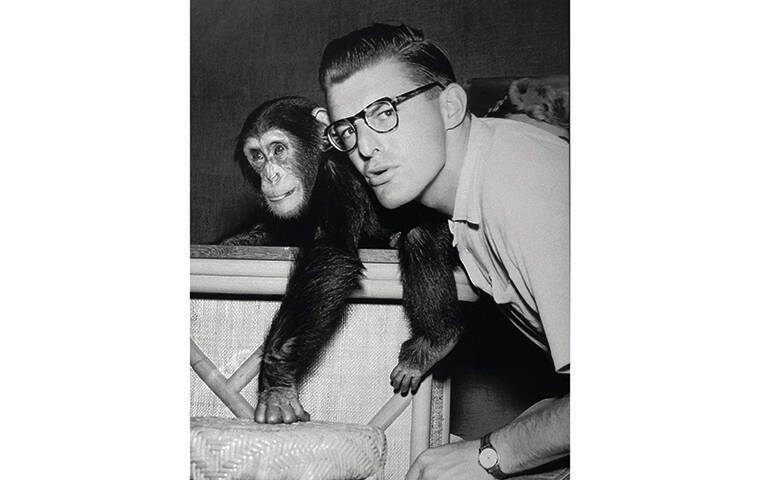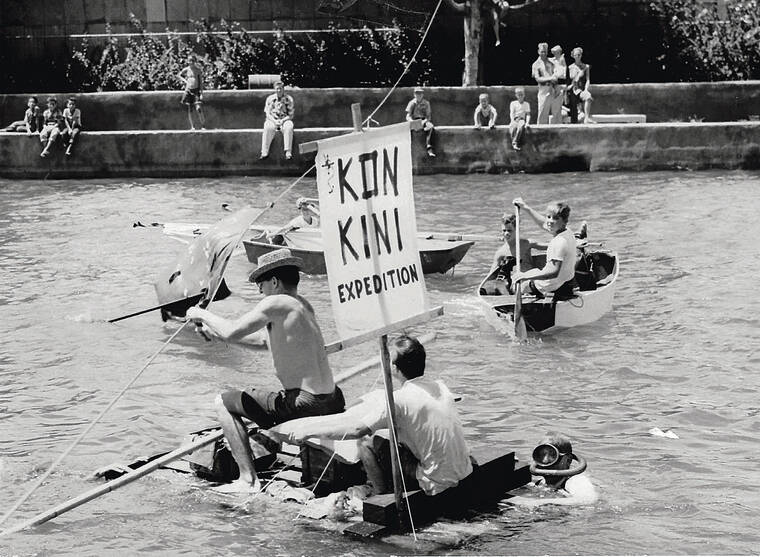Rearview Mirror: Kini Popo remembered as a pioneer in television

HONOLULU STAR-ADVERTISER
Carl Hebenstreit, better known as Kini Popo, and his pet chimp Peaches, had a morning show on KGMB in the 1960s. Hebenstreit died last week at age 93.

HONOLULU STAR-ADVERTISER
Kini Popo, wearing a hat, and Bob Krauss paddled a raft from the beginning of the Ala Wai Canal to prove that Waikiki Yacht Club members in the distant past may have originated in Kapahulu.

HONOLULU STAR-ADVERTISER
Kini Popo, wearing a hat, and Bob Krauss paddled a raft from the beginning of the Ala Wai Canal to prove that Waikiki Yacht Club members in the distant past may have originated in Kapahulu.



One hundred years ago in Hawaii, there was a race between two competitors to be the first to broadcast a live show on a newfangled device called radio.
KGU was neck and neck with KDYX (now KGMB). At 10:57 a.m. May 11, 1922, the words, “Hello, hello” were spoken on KGU. They may not have been very eloquent, but they were first.
KDYX got its equipment up and running at 11:12 a.m. “Aloha” was its first greeting.
Radio station KGU won the race by a scant 15 minutes. Thirty years later, in 1952, there was another race, this time to be the first to broadcast a television show.
KGMB was determined to be first this time, and it was in front. Who would it choose to stand in front of the camera and utter the first words broadcast on local television?
The station chose one of its radio disc jockeys who had “been in theater and had a stage presence”: Carl Hebenstreit. The young man had been hired less than six months earlier. The problem was no one could pronounce his name.
Don't miss out on what's happening!
Stay in touch with breaking news, as it happens, conveniently in your email inbox. It's FREE!
Maydell Taitano, a secretary at the station, suggested an alternative, “Why can’t he be Kini Popo?”
At that time a popular expression was “right on da kini popo” — which meant “right on the ball” or “exactly.” Sometimes it would be accompanied by a hand making an “OK” sign.
First on TV
On Dec. 1, 1952, it happened. “Around 5 o’clock I was ready,” Kini Popo said. “They had me dressed in a business suit. It was supposed to be casual, but I didn’t feel casual.
“It was hot as hell under the lights. And they took my glasses off because it was causing a reflection in the camera. Without them I couldn’t see anything.
“All I could see was a red light there. We were on the air, and I said, ‘Hello, everybody. Welcome to the first official broadcast of KGMB-TV.’
“I introduced a couple of people who spoke of the importance of this moment and how people would never forget it. It lasted about half an hour. I would introduce them and step out of the way and be careful not to trip over cables and fall down.
“We did get it launched, and then I think they immediately went to canned mainland programs like the ‘Jack Benny Show’ that were flown out here and played a week later.”
Hebenstreit — Kini Popo — died last week. He was 93. To honor his life, I thought I’d share some of my favorite stories about him.
‘Sunrise’
KGMB decided to create a morning TV show in 1954, and Kini Popo was selected as host.
“Sunrise” (a name KGMB still uses) was Hawaii’s first morning show and had guests such as Elvis Presley, Mel Torme, Ella Fitzgerald, Danny Kaye, Liberace and Ed Sullivan.
It was broadcast live in front of a studio audience from the station’s Kapiolani Boulevard studio.
One guest was Stan Freberg, who did voices in over 400 Warner Brothers cartoons. He didn’t show up as scheduled, Kini recalled. He was staying at the Hilton Hawaiian Village, which had just opened in 1955.
“The camera came on, and I had to tell the audience that Freberg was not around. They thought it might be a gag, but I said, ‘I’m gonna go get him. I won’t be long. It’s just around the corner.’
“This was not planned, but I couldn’t think of anything else that would satisfy the audience. Frankly, I wanted to get the hell out of there.
“A couple of people yelled, ‘Go get him, Popo.’ So, I got in my car and drove to the hotel, which was less than a mile away from KGMB’s studio on Kapiolani Boulevard.”
The hotel directed Kini to Freberg’s room. “I told him, ‘You gotta come down. There’s 200 people waiting for you.’
“Freberg got into my Austin Healey. We drove back to the studio as fast as we could. We went down the center aisle of the audience, up to the set and started talking. The audience reacted with whoops and hollers.”
Peaches
Many talk-show hosts today have a sidekick. Kini Popo had a chimpanzee named Peaches O’Rourke, purchased from a pet store in Kaimuki.
“Peaches was a sweetheart,” Kini said. “I wonder what she thought of me. I was the guy who showed up and had fun with her.”
Kini would often drive around town in his Austin Healey with Peaches in the front seat. People would stop and stare and wave. “Unfortunately, she was hard to handle, and in less than a year, we sent her to the San Diego Zoo.”
Win all the prizes
“I remember the Kini Popo show on television in the summer when I was in elementary school,” Mike Hamm told me. “It was a midday TV show and was sponsored by Longs drugstore.
“Kini Popo would have a segment where he would call a local resident on the phone and have them pick a letter from ‘LONGS.’ A prize was given for each letter, except for one letter, which would mean you lost all your prizes.
“If you got all the way through without getting the ‘lost prize’ letter, you would win all the prizes.
“Our household was called to play that game. Both my parents worked and I answered the phone. The producer said I could play the game. I was lucky and won all the prizes given that day, including an iron, a women’s straw hat and a Longs $25 gift certificate.”
Kon Kini
Reporter Bob Krauss joined The Honolulu Advertiser in 1951. His first article was about the opening of the film “Kon Tiki.”
In it, six Scandinavian scientists built and sailed a raft to determine whether Thor Heyerdahl’s theory that Polynesia was populated by people from South America, not Asia, was correct.
Kini Popo and Krauss decided to postulate a similar — but totally wacky — theory “that members of the Waikiki Yacht Club, in the dim, distant past, may well have migrated down the Ala Wai by raft from the low-rent district in Kapahulu.”
Thousands of people lined the banks of the Ala Wai Canal in 1954 to see the duo float past on a 4-by-6-foot wooden raft. It had a mast and sail.
A huge cheer erupted from the throng of onlookers as Krauss and Kini paddled away at 12:16 p.m. to begin their 1.5-mile journey.
When they reached the McCully bridge, they had to dismantle the mast in order to pass under it. That gave Krauss an insight. He understood why the Lurline didn’t dock at the Ala Wai Golf Course! Another scientific accomplishment for the duo!
Then it was snack time. They used a bottle opener, their only concession to modern navigational equipment, to enjoy a few beers, sashimi and potato salad.
As they approached the Kalakaua Avenue bridge, a banner suddenly appeared across the entire canal proclaiming, “Kapu Aku.”
Morning DJ Hal “Aku” Lewis was sending them a message that they were forbidden to pass. When the duo continued, Aku and his publicity man, Buck Buchwach, threw a barrage of tomatoes at the raft’s crew.
The tide was going out, and the Kon Kini finally arrived at the Waikiki Yacht Club at 2:23 p.m. Kini Popo fired his flare gun, signaling a successful conclusion to the expedition.
A bevy of beautiful bikini-clad models embraced the tired twosome. What was left of the raft was torn apart by youngsters eager for a souvenir, leaving nothing to donate to the Bishop Museum.
The expedition was a success, Krauss said. Waikiki Yacht Club members may have very well migrated from Kapahulu. It was a huge advance for science, he said.
Then Krauss and Kini Popo adjourned to the nearest bar for refreshments.
Trade Publishing
The Kini Popo show aired from 1954 to 1961. Kini later became president and CEO of Trade Publishing, which produces magazines and newsletters. He played a role in creating Generations magazine, which is focused on the senior market.
At Trade Publishing, Kini Popo was involved in some of the most interesting practical jokes I’ve ever heard, but I’ll save those for a future column.
———
Bob Sigall is the author of the five “Companies We Keep” books. Contact him at Sigall@Yahoo.com.



